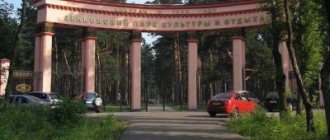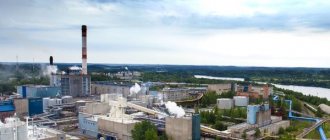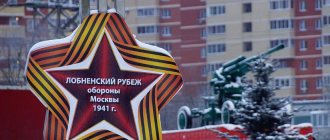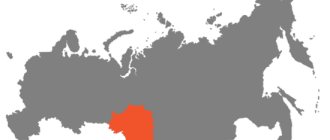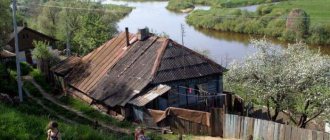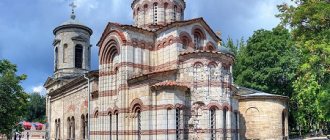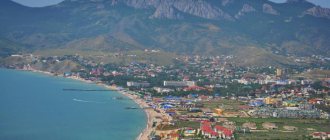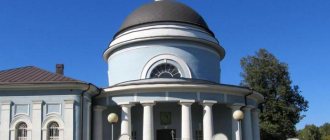General information and history of Mezhdurechensk
Geographically, Mezhdurechensk is located in the east of Novokuznetsk, the “southern capital” of the Kemerovo region; you can get to Kuznya by train in just an hour and a half. The distance between Mezhdurechensk and Kemerovo is about three hundred kilometers.
The city began to be built after the war - in the late 40s, within the boundaries marked by the Tomyu and Usa rivers (from which it received its name).
See also[edit]
- Book of memory of miners of Kuzbass/Mezhdurechensk
- Miners - Heroes of Socialist Labor (Mezhdurechensk)
| [ + ] Mezhdurechensk - a city of miners | |
| Perm region | Gremyachinsk • Gubakha • Kizel |
| Primorsky Krai | Partizansk • Artyom |
| Komi Republic | Vorkuta • Inta |
| Rostov region | Gukovo • Donetsk • Zverevo • Novoshakhtinsk • Shakhty |
| Tula region | Venev • Lipki • Nelidovo • Novomoskovsk • Uzlovaya |
| Chelyabinsk region | Bakal • Emanzhelinsk • Kopeisk • Korkino • Plast |
| Ghost towns | Kadykchan • Halmer-Yu |
Climate and ecology of Mezhdurechensk
The scarcity of architecture (after the war there was no time for excesses, and subsequently active construction was carried out mainly during the reign of Khrushchev, with understandable consequences) is compensated by the abundance of green spaces and an enviable attention to cleanliness. The surrounding nature complements the pleasant impression - the picturesque surroundings of the city seem to simply beg to be painted onto an artist’s canvas.
A temperature of thirty degrees on the thermometer can be seen here both in winter and in summer. In winter, of course, with a minus sign. Although temperatures of minus twenty (for December-January) and plus twenty (for July) are more typical, you need to understand that what makes the local winters truly severe is the high humidity, due to the close proximity to rivers and swamps. There is a lot of snow in winter, and since city services are working properly, you need to prepare for the sight of two-meter snowdrifts that grow on the roadsides by spring.
The environmental situation is quite acceptable; the level of air pollution is much lower than in other industrial centers of the region. It is at least significant that the snow here in winter is really white - a fact that is truly amazing for a mining town in Kuzbass.
Architectural appearance
The construction of residential buildings in the fifties proceeded rapidly - it was necessary to provide housing for the population of Mezhdurechensk. In 1950, 54 thousand people lived here. Ten years later - almost 80 thousand. Since the construction of residential buildings took place during the Khrushchev period, faceless panel houses predominate here. There are no unique architectural monuments to be found in Mezhdurechensk. At the same time, it is worth saying that the city was founded in a very picturesque area.
Population of Mezhdurechensk
The population, which grew until 1992, continues to decline. If in the early 90s about 107 thousand people lived in Mezhdurechensk, in 2011 the number of Mezhdurechensk residents decreased to 102 thousand. The numbers are not so scary if it weren’t for the noticeable trend of young people leaving the city. School graduates leave for Tomsk, Kemerovo or Novokuznetsk, and then settle in new places, not wanting to return to a place where decent money can only be earned as a manager or in a very dangerous job in a mine.
The city is therefore age-related, the number of pensioners is only ten thousand lower than the number of working-age population (about 30 and about 40 thousand, respectively).
Almost the entire adult population works in mines, open-pit mines and related market segments. This leaves an imprint on the general psychological atmosphere in the city. A hard worker who can speak to miners in their language will feel comfortable. But for creative youth it is better to look for a more hospitable place - especially since in school and student environments intolerance towards “outsiders” who cannot accept the rules of the local culture (very close to gop culture, by the way) is expressed much more violently.
It is curious that the above does not apply to tourists - anyone can come to Mezhdurechensk, for example, to go skiing, without fear for their own comfort.
Theoretically, Mezhdurechensk has all the conditions for the full development of a versatile personality: there are branches of good universities, a children's art school, a children's choir school, and a creativity center. However, the social environment does not contribute to the formation of a harmonious personality. Perhaps only future athletes are really good here - one and a half hundred sports facilities, including a stunning ice palace, are at the complete disposal of residents.
However, informal youth subcultures also somehow manage to live in an environment that is aggressive for them, and in recent years they have even developed. Although the percentage of “emigrants” to large cities among them is significantly higher. Again, it should be noted that a person who grew up in Mezhdurechensk and became interested in alternative music, gothic (and so on) feels much better here than a visiting “informal”.
Population[ | ]
| Population | ||||||||||
| 1959[18] | 1962[19] | 1967[19] | 1970[20] | 1973[19] | 1975[21] | 1976[22] | 1979[23] | 1982[24] | 1985[25] | 1986[22] |
| 54 513 | ↗64 000 | ↗79 000 | ↗81 739 | ↗86 000 | ↗89 000 | →89 000 | ↗91 296 | ↗96 000 | ↗103 000 | →103 000 |
| 1987[26] | 1989[27] | 1990[28] | 1991[22] | 1992[22] | 1993[22] | 1994[22] | 1995[25] | 1996[25] | 1997[29] | 1998[25] |
| ↗104 000 | ↗107 014 | ↘104 000 | ↗108 000 | →108 000 | →108 000 | ↘107 000 | ↘105 000 | ↘104 000 | →104 000 | →104 000 |
| 1999[30] | 2000[31] | 2001[25] | 2002[32] | 2003[19] | 2004[33] | 2005[34] | 2006[35] | 2007[36] | 2008[37] | 2009[38] |
| ↗104 500 | ↘104 400 | ↗105 300 | ↘101 987 | ↗102 000 | ↗102 300 | ↗103 000 | ↗103 700 | ↘103 500 | ↗103 800 | ↗103 950 |
| 2010[39] | 2011[40] | 2012[41] | 2013[42] | 2014[43] | 2015[44] | 2016[45] | 2017[46] | 2018[47] | 2019[48] | 2020[49] |
| ↘101 678 | ↘101 575 | ↘100 725 | ↘99 809 | ↘98 895 | ↘98 831 | ↘98 734 | ↘97 895 | ↘97 060 | ↘96 159 | ↗96 299 |
| 2021[50] | ||||||||||
| ↘96 088 | ||||||||||
Population as of January 1, 2021: 96,088.
As of January 1, 2021, in terms of population, the city was in 177th place out of 1116[51]cities of the Russian Federation[52].
Districts and real estate of Mezhdurechensk
The city is small and is officially divided into only two districts - Western and Eastern. Interestingly, the unofficial zoning follows the official one, also dividing Mezhdurechensk into two large territories (with some nuances, of course).
Mezhdurechensk Map
The eastern district is usually called the “old town” or simply “the city”. Residents of the western part of Mezhdurechensk, heading here, say: “let's go to the city.” All administrative buildings, the Sports Palace, the main park of the city, and the main market are located here. There is already little housing being built in the city, and specifically in the eastern region there is a problem with new houses. On the secondary market you can find excellent “Stalin” apartments, although at a price slightly higher than the regional average (more about the cost of apartments below).
The area is relatively calm, clean, and looks attractive from the facade. The courtyards, of course, are less attractive, but this does not distinguish Mezhdurechensk from other Russian cities. The population, in a provincial way, is intolerant of new things, but if you do not have a long hair, are not a goth, not a hippie, it is quite possible to live here. You should always be prepared for the abundance of “gopniks” and the festivities of drunken miners (especially on weekends) (this is relevant for all areas). There is, perhaps, only greater wariness towards strangers in the “old Mesopotamia”, the private sector of the old city - where normal socialization can take quite a long time. At the same time, a private house in Mezhdurechensk can only be bought out of a great love for fiddling around in the garden; the lack of normal sewerage and hot water supply, and stove heating make the private sector very unattractive for visitors.
Eastern region
The western district of Mezhdurechensk is called “new”; there are more new buildings here, many high-rise buildings (and this territory began to be populated later than the old city). One of the streets (Kommunistichesky Prospekt) is completely pedestrian. Mezhdurechensk is generally a very green, very clean city, and on the “local Arbat” this is especially noticeable.
Mezhdurechensk Western region
The only unsightly place in Mezhdura is also in the west - Nakhalovka, where the private sector is localized. This is the dirtiest part of the city, partly due to the large percentage of marginalized people among the population, and partly due to a poorly organized garbage collection system. You can only buy housing here if you have a lot of money; in addition to all the typical problems of living in a private house, there are huge piles of waste on the streets.
In general, the New City is a pleasant place to live. In principle, the Old Town is in no way inferior to it (Mezhdurechensk is small anyway, and you can get to any point very quickly), but buying an apartment in the Western district is a more realistic task.
Housing prices can be unpleasantly surprising. The fact is that builders incur additional costs due to the need to build high seismic resistance (weak earthquakes in Mezhdurechensk have not surprised anyone for a long time, there have been no strong ones, but protection from them is necessary). Therefore, the price per square meter of 26-27 thousand rubles is considered gentle here (and is rare, 30-32 thousand per meter is common). If you try, it’s quite possible to find a “one-room apartment” within a million rubles, and a “two-room apartment” within one and a half. Prices on the secondary market are approaching prices for new apartments due to high demand. A small private house for 300 - 500 thousand will only be bought by someone who likes to overcome difficulties.
Religion[ | ]
Russian Orthodox Church
- Chapel in honor of the Holy Great Martyr Barbara[17]
- Church of All Saints
- St. Nicholas Church
- Church of the Holy Trinity
- Temple of the Kazan Icon of the Mother of God (Usinsky settlement)
Other denominations
| This section of the article has not been written. According to the plan of one or more Wikipedia contributors, a special section should be located in this place. You can help by writing this section. This mark was set on December 31, 2021 . |
City infrastructure
Utilities in the city cost about the same as in other cities in the region. The heating tariff is slightly higher - but this, as the authorities explain, is due to the high costs of communal boiler houses.
Prices:
- heating – 22.03 rubles/sq. meter;
- cold water – 10.54 rubles/cubic meter;
- hot water – 66.10 rubles/cubic meter;
- electricity – 1.53 /kWh.
There is certainly money in the city - prosperity is ensured by huge deposits of expensive coking coal. Surprisingly, the administration spends the profits wisely: the streets are clean, tidy, the roads are smooth - it’s a pleasure to see. There is even an opinion about Mezhdurechensk as the cleanest city in the region - and it has a right to exist.
There is only one problem area - Nakhalovka. Local activists, who every now and then take on the task of tidying up the private sector, argue that it is not only local residents who are to blame for the mountains of garbage (although they are among the main suppliers of waste). Garbage is brought here from almost the entire Western region of Mezhdurechensk; even landfills of obvious “construction” origin were noticed.
Mezhdurechensk Nakhalovka
There are no particular complaints about transport, the network of bus routes covers the entire city, although the problem typical for Kuzbass - the early departure of minibuses from their routes - is also relevant for Mezhdurechensk. It’s difficult to leave somewhere after nine.
Mezhdurechensk is connected with Novokuznetsk, Kemerovo, Tashtagol and Tomsk by intercity bus routes. In this case, you can get to the “southern capital” (on the same bus or train) and go to any point in the region or neighboring regions from there.
About two dozen companies provide taxis - you can choose a taxi according to your taste and wallet. The minimum price is one hundred rubles, but usually you have to pay more.
Not everything is so rosy with kindergartens - despite the fact that in 2011 a couple of new institutions for preschoolers were opened in the city, a fairly large queue remains. Fortunately, there will definitely be somewhere to send a grown-up child - 32 operating secondary schools are more than enough. There are many sports sections, 7 sports schools (including ice hockey, rhythmic gymnastics, etc.), cultural development institutions are rather poorly represented, although this should not interfere with caring parents: in Mezhdurechensk a child can learn to draw , and sing and play musical instruments.
Media[ | ]
| The section lacks links to sources. Information must be verifiable or it may be deleted. You can edit the article to add links to authoritative sources. This mark was set on August 14, 2013 . |
Press
- "Contact"
- "The Miner's Banner in the New Millennium"
- "Chastnik-M"
- "Advertising Mezhdurechensk"
A television
- First channel
- Russia 1 / State Television and Radio Broadcasting Company Kuzbass
- TV Center
- NTV
- Channel 5
- REN TV
- STS (STS-Kuzbass)
- TV3
- TM-KVANT (City TV channel)
- Mezhdu.net (City TV channel)
Radio stations
- 70.6 FM – Radio Russia
- 93.4 FM – Road Radio
- 97.5 FM - Humor FM
- 99.8 FM – Radio Dacha
- 100.2 FM – Apex Radio
- 100.8 FM – Radio Russia
- 101.8 FM - Kuzbass FM, with local radio "KVANT Radio" included
- 103.3 FM - Europe plus
- 103.7 FM – Russian radio
- 104.7 FM - NRJ
- 105.3 FM - Radio for two
- 106.4 FM – Radio Vanya
- 107.7 FM – Autoradio
Enterprises and work in Mezhdurechensk
The city lives by coal mining; the main employer of Mezhdurechensk is the famous (somewhat notorious) Raspadskaya mine. The miners, whose service takes place at the Raspadskaya mine, are definitely the wealthiest part of the Kuzbass working class. When the plan is fulfilled, the salaries of the “slaughterers” reach 80 thousand rubles.
Most recently, they paid at Raspadskaya at average regional rates; the impetus for increasing the well-being of miners was the methane explosions in May. They led not only to the death of hundreds of miners, but also to spontaneous rallies (which ended with the blocking of the railway and the dispersal of demonstrators by riot police). In the end, the management decided to satisfy the demands of the protesters, who also claimed that their work was unjustifiably low.
The increase in wages, as expected, did not affect other mines and open-pit mines in the city, where miners at the face can still count on a maximum salary of 30-40 thousand (and not “miners” - 15-25 thousand). In principle, even with such a salary you can live well in the city - prices, if higher than the average in Kuzbass, are not much.
Work on open-pit mines (there are four of them in Mezhdurechensk - “Tomusinsky”, “Olzherassky”, “Krasnogorsky” and “Mezhdurechensky”) is relevant for excavator operators and Belazian specialists. Salaries often depend on the specific volume of coal mined, but it is quite possible to earn 20-25 thousand without superhuman efforts.
Women are left to stay at home or go to work in service and sales. A sales consultant most often receives a small daily salary and a percentage of sales (300 rubles + 3% is still a very good option). There is a chance to get into one of the bakeries or Slavyanka, which makes beer for the entire south of the region, but vacancies rarely appear there.
Crime
Criminal showdowns in Mezhdurechensk ended in the early 2000s. The most notorious cases of that time were bandit mines and open-pit mines. Moreover, the bandits were interested not only in coal, but also in expensive materials associated with mining/driving activities. For example, diesel fuel was actively removed from the open-pit mines.
Widely known in the 90s were the Fomin brothers, who were initially involved in racketeering on the roads, and actively tried to penetrate the open-pit mines - the “coal and solar feeding trough” of the local gang. In 1996, one of the brothers was killed, and the second had to leave the city in 2002.
To this day, people in Mezhdurechensk remember Mikhei, the thief in law, who “held” one of the cuts. His story ended in the winter of 1996. His contract killing was remembered for the fact that the killer with several bullet wounds was taken to the same hospital where Micah died. The medical facility was quickly cordoned off by people from Mikhei’s retinue; only policemen from the 6th department were able to prevent the massacre. It is also noteworthy that the killer was taken to trial (apparently on the principle of “out of harm’s way”) two days later, when he still could not really move.
Now there is no shooting on the city streets, and ordinary people do not have to fear a stray bullet. Although incidents still happen. The talk of the town was the trip of one Belarusian who carried coal not with a permit (coal coupon issued to miners and all people involved in the industry), but at gunpoint. At the end of the trip, he was finally paid for the coal.
Evil tongues say that instead of bandits in Mezhdurechensk there are now bosses. There are rumors about family and friendly connections between city, judicial, mine, and railway bosses. And that all the deputies are prone to swearing, drunkenness, corruption, and violence against secretaries. However, rumors are only rumors, so they should not be fully believed.
In addition, robberies, thefts (sometimes murders) and other “minor, everyday” offenses, even if they are not in the order of things, are certainly considered phenomena that do not cause surprise.
In general, it’s possible to live, the crime rate here is higher than in such a relatively calm city as Tomsk, but is fully consistent with regional indicators. Kuzbass has always been restless, but now, in comparison with the 90s, the crime situation can be called uncritical.
Sights of Mezhdurechensk
Mezhdurechensk is a real paradise for ski lovers. The necessary infrastructure is available on Yugus Mountain and Sosnovaya Mountain. Those heading to Yugus can have a snack or a hearty lunch right at the foot of the mountain - in the Bear restaurant or in the Three Peskarya cafe. Although the prices there are slightly higher than usual in the city (which is not surprising: these establishments are designed primarily for tourists). Those who like a relaxing holiday can grill kebabs - the owners have allocated a place for this.
The cost of renting ski equipment is 150 rubles per hour, and you can rent it for the whole day at a “wholesale price”, saving significantly (for only 600 rubles).
In the summer, both visitors and local residents willingly climb the Celestial Teeth - mountains located east of Mezhdurechensk. It is noteworthy that this can be done by both experienced climbers and those simply interested. The so-called system “shelters” (premises fully equipped to receive tourists) allows you to lay out routes of varying complexity. And the level of service for Russia (and extreme tourism in general) here is extremely high: at a rest stop you can go to the bathhouse and to the canteen. Shelter workers not only accommodate arriving tourist groups and provide them with all the necessary services; they also usually provide emergency assistance in case of emergencies (which, of course, are not uncommon in the mountains).
In the city itself, a favorite place for local residents to relax is a well-maintained park (in the “old district”). The simple sights are captivating, and the landscaping evokes only positive emotions.
Kommunistichesky Avenue is also good for walking - by the way, there are many good mid-price cafes there: Tu-shka 154, IREZUMI (Sushi Bar), Coffe Story coffee shop and others.
Perhaps the best of the cinemas is Kuzbass, located next to the city park, on 50 Let Komsomol Street.
City management[ | ]
Authorities and city management
According to the Charter of the Mezhdurechensky urban district[4]:
- The Council of People's Deputies of the Mezhdurechensky Urban District is a representative body of local government,
- The head of the Mezhdurechensky urban district is the head of the municipal formation,
- Administration of the Mezhdurechensky urban district is the executive and administrative body of the municipality,
- The Chamber of Control and Accounts of the city of Mezhdurechensk is the financial control body of the municipality.
Heads of the city
| This section of the article has not been written. According to the plan of one or more Wikipedia contributors, a special section should be located in this place. You can help by writing this section. This mark was set on December 31, 2021 . |
Council of People's Deputies
| The section lacks links to sources. Information must be verifiable or it may be deleted. You can edit the article to add links to authoritative sources. This mark was set on August 17, 2021 . |
In 2013, 17 deputies from United Russia, 2 from SR, 2 from LDPR, 1 from the Communist Party of the Russian Federation were elected to the council. In the 2021 elections, United Russia received 31%, LDPR - 24%, Communist Party of the Russian Federation - 21%, SR - 17%. There are factions: United Russia - 12 people, SR - 3 people, Communist Party of the Russian Federation - 3 people. , and non-fractional (8 people). There are 26 deputies in total.
